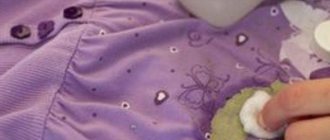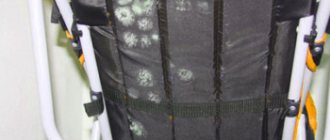How to iron a veil without harming the material
A veil is an important accessory for every wedding. However, due to improper storage or transportation, it can be severely wrinkled, as a result of which the appearance is greatly affected. Ironing or steaming helps restore neatness and aesthetics to products. But it is important to carry out this procedure carefully and in compliance with the recommendations for tissue care.
The veil is made from tulle, tulle, lace and silk. These are delicate fabrics that require special care. Most often, tulle is used for veils. This is a lightweight sheer mesh fabric that, when folded in several layers, gives incredible volume. Let us figure out how to iron a veil at home without harming the fabric.
How to iron a veil correctly
Before washing or ironing the product, be sure to read the label. The symbols will tell you how to properly care for an item made from this material. You can find an explanation of the signs here. As a rule, ironing a veil is not recommended. But if you choose the appropriate mode and heating temperature, tulle can be ironed without fear of ruining the thin, delicate fabric.
To properly iron the veil, use the lowest temperature of up to 100 degrees. For tulle, we allow heating up to 120 degrees. Dry gauze, a special ironing cloth or thick paper sheets are placed on top of the material.
If the product has areas with beads, flowers or other decorative elements, cover the parts with a towel. Please note that ironing such places is quite difficult.
First iron the item without steam. As you go, constantly straighten out folds and creases. If they still remain, you can use steam. It is important that the soleplate of the iron is clean and free of stains and burnt areas.
Otherwise, yellow marks will remain on the material. Tulle should only be ironed dry and through a dry cloth! If you are afraid of ruining the fabric, try other ironing methods without using an iron.
How to iron a tulle veil
It is necessary to iron any veil in a special way, since the finest delicate fabrics are always used to sew them (most often tulle, lace, silk and tulle).
The latter is a lightweight mesh translucent material with a fairly rigid structure, which allows it to hold its shape well. However, if wrinkles appear on it, it is not so easy to eliminate them. It is worth remembering that tulle is very vulnerable to high temperatures, and an iron can easily burn through it. A light pre-wash may be required before ironing. Before ironing the tulle, it will be useful to soak it briefly in water with fabric softener and gently wash it by hand. Then the product must be dried in a vertical, straightened position. Perhaps after this procedure ironing will not be required at all.
If ironing is necessary, then first you need to make sure that its surface is perfectly clean and will not stick. Then you need to set the minimum temperature or “synthetic” mode. It is also recommended to prepare in advance:
- ironing cloth (gauze or white cotton cloth is suitable);
- sheets of thick paper;
- towel.
An ironing cloth or paper must be placed on top so that the material does not come into contact with the surface of the iron. A towel will be needed to cover areas with decorative details and thus protect them from the temperature (a veil is often decorated with sequins or small artificial flowers, which can simply melt if touched by an iron).
Find out how to quickly organize your closet.
Read here to find out what products you can use to replace antistatic agents for clothing.We'll tell you how to remove stains from kitchen towels here.
Ironing in the salon
Sometimes an item seems too vulnerable for home manipulation. You can always ask for help at the wedding salon where it was purchased. Not only do they know how to iron a veil and wedding dress, but they will most likely do it for free. As a result, all details of the wedding dress will be in impeccable condition in advance.
Salons never use an iron to iron wedding dresses. Most often, dresses, suits and other accessories are tidied up using high-quality steamers. Therefore, ironing in a salon is the safest option.
How to iron a veil without an iron
- If you have time, you can lightly spray the product with water and hang it on a hanger, straightening the fabric. Leave the veil in this position for one to two weeks, after which it will straighten on its own. This is the most gentle and safe option to give the product an attractive appearance. Therefore, after you have brought the item home, immediately remove the material from the packaging and hang it up;
- A suitable option is to use a steam generator, a hand-held steamer or an iron with a vertical steamer function. In this case, hang the product on a hanger and straighten the material. Pour water into the device and heat to minimum temperature. Treat the surface while holding the device at a distance. Periodically smooth the veil and remove wrinkles;
- You can use a hairdryer on medium setting. This is a kind of analogue of a steamer. First, spray the veil with water, and then dry the product with a hairdryer vertically from top to bottom;
- The traditional method of steaming and smoothing at home is a bath with boiling water. To do this, fill a bathtub or large container with boiling water, hang a veil over the container and straighten the fabric. Leave the product in a closed bathroom for 20-30 hours. Larger items (for example, a wedding dress) need to be steamed for several hours;
- Small parts and elements, single folds are smoothed over a stream of steam. To do this, hold the area over a kettle or pan of boiling water.
How to iron a veil
Numerous fittings of wedding dresses lead to the fact that they need to be refreshed or cleaned even before the holiday. You can remove simple stains and steam the dress yourself, but the success of cleaning depends on the material. Dresses made of organza, chiffon, silk, tulle can be cleaned only from simple dirt and stains.
Trust a professional if your attempts are unsuccessful, as further efforts will lead to disastrous results. If the joyful troubles are already behind you, then the dress can be cleaned and even washed by hand or in the machine. It is advisable to get rid of stains as quickly as possible. You can start washing the entire wedding dress immediately in situations where:
- you need to refresh your outfit;
- Extensive contamination needs to be removed;
- there are water-based stains and traces of food;
- the dress is made of thick fabric, polyester;
- The amount of decor on the product is minimal.
Cleaning should be done in the following cases:
- slight dirt on a dress made of light fabric;
- a few stains located mainly in one place (for example, the hem is dirty);
- the presence of sewn or glued decorations on the product;
- if the dress is separate, and the stain is found on one of the components: corset or skirt.
The purpose of cleaning is to remove dirt by partially processing the wedding dress. It is carried out this way:
- Hang the dress on a hanger.
- Treat the stains with the chosen product using soft sponges or toothbrushes, and gently rub the areas with decor with your hands.
- Rinse the soap thoroughly with clean water.
When choosing a cleaning product, consider the recommended care for the fabric. Examine the tag on the product: it usually contains information.
It is important to dry the dress carefully, taking into account the type of fabric.
- Dry the dress in a warm room on a hanger, with the exception of silk, satin and natural fabrics that lose their shape.
- Do not use a hanger made of untreated wood or rope to avoid creases in the material.
- Dry the outfit horizontally, placing it on a drying rack and a white terry towel.
- You can straighten the dress without deformation by placing it on a regular vinyl-lined flip-up drying rack installed in the bathtub.
- Spread the product on a towel that has been previously draped over the shower stall if there is a stall installed instead of a bathtub.
- It will be easier to iron later if you straighten the layers of tulle while drying.
It is recommended to always use the appropriate temperature setting for the specific type of fabric.
Aggressive detergents, high temperature water and automatic washing are contraindicated for tulle. Wash the veil by hand and rinse, adding starch to the water to maintain its shape. It’s easier to smooth it out if you follow these tips:
- spray the tulle with water from a spray bottle;
- Start ironing from the edge of the veil to make sure the temperature is set correctly;
- iron it through the fabric at low temperature;
- If you use a steamer, lightly pull the tulle and hold the edges.
If you are afraid of burning your veil with an iron, use the proven folk method of smoothing tulle without an iron. The principle is based on the fact that water acts as a weighting agent, straightening creases in the veil. The veil dries quickly naturally, as it is made of thin material.
- Wet the veil with cool water.
- Carefully hang the veil over the bathtub or basin, avoiding creases in the material. Under the weight of the water, the creases will straighten out.
In some cases, you can clean and wash a wedding dress at home using improvised means. It is advisable to start cleaning as quickly as possible and find out the type of fabric and the recommended cleaning products and washing modes for it. Choose products that are gentle on the fabric structure. If you can't handle it yourself, contact a dry cleaner.
We suggest you read How to clean a sewer pipe with soda and vinegar: 3 proven methods
You will be lucky if your dress is made of wrinkle-resistant fabric. Ironing some individual areas is much easier and faster than putting the entire outfit in order, especially if it is made of capricious, delicate and highly wrinkled material. If you get such a “problematic” dress, then you won’t be able to cope without an extra pair of hands. A friend's help will be most welcome.
It should be noted that today the industry produces a huge range of beautiful materials, different in texture and properties, with the help of which tailors and designers express all their imagination. It is thanks to the variety of fabrics and the experience of sewing professionals that wedding dresses acquire their exquisite beauty and individuality (uniqueness).
Unfortunately, not everyone understands the types of fabrics and has such necessary information. Therefore, when ironing your wedding dress, be extremely careful. After all, you’re unlikely to want to take souvenir photos in a singed dress. The responsibility doubles even more if you rented the wedding dress.
It would probably be a good idea to remind you that any stains or dirt must be removed before the ironing process, otherwise the high temperature will only help them to take hold in the fibers of the material.
All plastic or other decorations must be temporarily removed, otherwise they may melt after ironing or steaming.
Salons often warn that tulle products cannot be ironed, and many brides, when they find small bruises, do not know how to remove them. In fact, you can iron wedding items, including a veil, with an iron; the main thing is to set the mode and temperature correctly so as not to spoil the thin fabric.
To protect the item from burning, it is recommended to iron it using gauze or a special ironing cloth. But if decorative elements are sewn onto it (for example, beads or glass beads), then this method will not allow all the wrinkles to be smoothed out efficiently; in addition, the decorative parts may be damaged due to temperature.
Some items can be ironed efficiently only with steam. But you don’t need to immediately set the steaming mode: first, you should just try ironing the folds in a delicate mode through gauze. If this is not enough, you can turn on steam.
Ironing a veil can be inconvenient, as it is often long and has many folds. Here you cannot do without the help of another person to help straighten it out.
If there is still enough time before the wedding (2-3 weeks), then the veil can simply be lightly sprinkled with water and hung in the closet so that the fabric has time to straighten naturally. This will minimize the need for further processing and the risk of damage. If there are only a few days left, more drastic measures are needed.
Steamer
Sometimes the veil is richly decorated or has many gathers, which excludes the possibility of regular ironing. In this case, this item can be tidied up using vertical steaming: to do this, hang it on a hanger and walk along its entire length with a steamer (or an iron in the appropriate mode) at a short distance. This method is considered the most gentle and safe for delicate tulle products.
In the bathroom
You can also use the well-known “home” method of steaming without special equipment. The veil must be hung over a bathtub filled with hot water. It will be enough to hold it over the steam for 15-20 minutes so that all the creases in the fabric are straightened.
There is another way to quickly smooth out bruises. It consists of using a spray bottle with water and a regular hair dryer with a medium drying temperature. First, all the irregularities need to be sprayed with water, and then dried with a hair dryer in a vertical downward direction. This method is a home analogue of steaming.
Sometimes only a couple of small but noticeable folds form on the veil. In this case, there is no point in processing the entire product. You can simply try to smooth out this area by holding it straightened over a kettle or pan of boiling water.
It is necessary to iron any veil in a special way, since the finest delicate fabrics are always used to sew them (most often tulle, lace, silk and tulle). The latter is a lightweight mesh translucent material with a fairly rigid structure, which allows it to hold its shape well.
A light pre-wash may be required before ironing. Before ironing the tulle, it will be useful to soak it briefly in water with fabric softener and gently wash it by hand. Then the product must be dried in a vertical, straightened position. Perhaps after this procedure ironing will not be required at all.
If ironing is necessary, then first you need to make sure that its surface is perfectly clean and will not stick. Then you need to set the minimum temperature or “synthetic” mode. It is also recommended to prepare in advance:
- ironing cloth (gauze or white cotton cloth is suitable);
- sheets of thick paper;
- towel.
An ironing cloth or paper must be placed on top so that the material does not come into contact with the surface of the iron. A towel will be needed to cover areas with decorative details and thus protect them from the temperature (a veil is often decorated with sequins or small artificial flowers, which can simply melt if touched by an iron).
Ironing in the salon
How to wash, dry and store a veil
Sometimes it becomes necessary to wash a veil. In this case, you also need to follow a number of rules and recommendations. You need to wash the veil by hand, after first removing the decorative details (bows, hairpins, etc.). Use washing powders for delicate fabrics and warm water up to 40 degrees.
Dilute the powder in water, carefully rinse the accessory, and rub heavy dirt with your hands. Items made of tulle, silk or tulle should not be rubbed, twisted, squeezed or wrung out too much!
After washing, rinse the veil first in warm and then in cool water with the addition of fabric softener or a small amount of vinegar. It will return the original brightness and maintain the color of the product.
If the label allows it, you can wash the veil in the washing machine. To do this, choose a delicate mode with a temperature of up to 40 degrees without spinning. You need to rinse with your hands. After washing and rinsing, do not wring out the veil, but immediately hang it on a rope in the bathroom using clothespins. Once the water has drained, shake off the items and straighten out any wrinkles.
You need to dry the veil in a vertical position, hanging it by the top and straightening the material well. Or the product is laid out on a terry sheet or towel in a horizontal position. The veil can only be stored straightened and suspended in a relatively free space so that other clothing does not put pressure on the product.
For long-term storage it is better to use a special case. You cannot fold or roll tulle! For more information on how to iron, wash and store tulle items, read the link https://vsepodomu.ru/garderob/kak-stirat-i-gladit-fatin/.
Source
How to prevent the appearance of folds and creases in tulle
In order not to deal with bruises on tulle, it is better to immediately try to prevent their occurrence. To do this, you just need to learn how to properly wash and dry products made from this delicate material.
Important! Proper washing and drying will save you from having to iron out tulle!
Rules for washing and drying material:
- It is preferable to wash tulle by hand or it is acceptable to do it in a washing machine using the “delicate fabrics” mode.
- Washing should be carried out at a temperature of no more than 40 degrees .
- The speed of the washing machine drum must be set low so that the fabric does not deform or wrinkle.
- Conditioner added during washing can reduce creases in the fabric.
- To add brightness to colored tulle, you can add a little table vinegar to the water when rinsing.
- When washing by hand, it is not recommended to wring or twist the product; it is better to hang it on hangers for a while. When washing in a machine, also try to do without spinning or set the “delicate spin” mode.
- After washing, it is recommended to shake items made from this material thoroughly to help them straighten out better. You can insert tubes rolled from thick paper into the sleeves of the dress so that they do not wrinkle again.
- It is not recommended to dry tulle items in the washing machine if it has such a mode.
- By air drying the fabric vertically, you will avoid unnecessary folds and creases.
- You can iron the material while still wet, using a cloth and an iron temperature of no more than 100 degrees. It is more convenient to iron an outfit starting with large parts.
We hope our article helped you find the answer to the question: “How to iron tulle easily and simply?”
And now you know what to do to make your wedding dress, veil, skirts or performance costumes look neat. As you can see, putting tulle items in order is not so difficult if you know some little tricks. The methods and tips we have given will help you preserve your outfits made from this capricious but beautiful translucent material for a long time, whether at home or on a trip.
Source
How to iron a veil
Preparing for a wedding is the most exciting and touching moment that any bride will forever remember. Particular attention is always paid to the choice of dress and wedding accessories, which include gloves, a garter, a shawl, shoes and, of course, a veil. And if there are practically no problems with small parts, then if stored and transported incorrectly, the veil can become very wrinkled. This is especially unpleasant when the problem was discovered right before the celebration. But don't panic in advance! We'll tell you how to quickly iron your veil so that your look remains simply irresistible.
Read how to iron a wedding dress here
How to steam a veil at home
Using steam when ironing a veil takes much less time and requires a minimum of physical effort. And the folds on the product are aligned much better.
This method is recommended when the veil is decorated with additional decor. Ironing such a thing with an iron will be very difficult, if not downright dangerous, but a steam generator will cope with the task perfectly.
Steaming a veil step by step looks like this:
- hang the veil in a vertical position so that it flows along its entire length;
- turn on the device and wait until it warms up;
- As soon as the equipment starts supplying steam, process the entire veil with smooth movements from top to bottom, paying special attention to especially crumpled areas.
Take your time and try to work very carefully. Speed is not at all the key to success, but a careful attitude and caution will bring a much more positive result.
How to iron tulle at home
Any fashionista in whose wardrobe a tutu skirt made of tulle occupies a special place will confirm that it is incredibly difficult to deal with folds in this fabric. Light and delicate mesh requires special care, since without certain precautions it can easily be damaged. However, you won’t have to go out in public wearing a wrinkled skirt, since it is still possible to smooth out the tulle.
The methods that housewives use in everyday life will not surprise anyone today - these are smoothing with an iron and steaming with a steam generator. But in the absence of the latter, folk craftsmen save themselves with the help of tricks that are not inferior in efficiency to special ironing devices. So, you can smooth a tulle skirt using the following means:
- an iron equipped with a delicate ironing function;
- steam generator or steam iron;
- steaming in the bathroom or over a pan of boiling water;
- hairdryer
If we are talking about a wedding dress made of tulle, then in addition to the listed funds, the bride will have to arm herself with patience, since the whole process will take at least an hour. We will describe each smoothing method in detail.
How to iron a tulle dress with an iron
Any modern iron has a mode switch, which every housewife should be familiar with. For delicate tulle clothing, only the delicate mode with a minimum heating temperature is suitable. If you have to deal with creases on a wedding dress, then for ironing you will additionally need:
- ironing board;
- special stand for smoothing sleeves;
- thick fabric;
- soft towel;
- sheets of thick paper.
Before starting the procedure, you should carefully inspect the soleplate of the iron. If there are any marks on it, you will have to get rid of them, otherwise the outfit will be hopelessly ruined.
Start smoothing the dress from the top, since processing the skirt is much more difficult and takes longer. The bodice often has embroidery or beads - they are covered with a soft towel to prevent the delicate details from melting.
Then they start on the skirt. This is the most labor-intensive process, since the skirt is usually decorated with numerous ruffles and folds. The bottom of the dress begins to be smoothed from the front, and then the back is processed. The tulle must be covered with a thick cloth so that the sole of the iron does not come into contact with the fragile mesh. The ironed parts are inspected and, if necessary, the iron is passed over them again.
When most of the work is left behind, the dress is straightened out on the board so that the skirt can be carefully inspected. If everything is in order, then it’s time to pay attention to the finer details of the outfit. For the sleeves you will have to use a small stand, which is usually purchased complete with an ironing board. The sleeve is pulled onto a stand so that the iron can be passed over it. It is important not to forget about thick fabric that protects the dress from the heat of the iron!
To prevent the sleeves from becoming wrinkled again, tubes are rolled out of plain paper or loose cardboard. They are inserted into the sleeves of a hanging dress.
How to steam a tulle skirt
Such a convenient household assistant as a steamer exists in dozens of different variations: vertical steamers, steam brushes, steam cleaners, irons with a steam function, more advanced irons with steam generators, and so on. When you have to deal with clothes made from delicate fabrics, any of the listed devices will do. However, professionals do not recommend using a regular iron with a steam function, especially ironing and steaming at the same time.
To achieve excellent results with any steaming device, just follow these simple instructions:
- Carefully hang the product, smoothing it with your hands;
- Process large items of clothing;
- Work on small details - sleeves, collar.
Any of the modern household steamers is suitable for large tulle products - wedding dresses, curtains. The versatility of these helpers also lies in their effectiveness, because steamers can handle the most difficult creases.
How to steam a tulle dress in the bathroom
Back in Soviet times, fashionable young ladies got used to smoothing delicate fabrics by hanging clothes made from them over a boiling kettle or pan. The ladies were resourceful, and the steam from boiling water did the job perfectly. You can arm yourself with this method today, but if you have to deal with a wedding dress made of tulle, then you can’t get by with a saucepan. This means that you will have to put the dress in order in the bathroom.
- Having tightly closed the door to the bathroom, the bathtub is filled with hot water;
- The dress is hung vertically, not far from the steam source;
- After a couple of hours you can check the result! By the way, you can also smooth a veil for a wedding dress in a similar way.
Storage rules
To prevent the veil from becoming wrinkled again, it must be stored appropriately. After ironing or steaming, do not put the product in a closet, much less on a shelf. Hang the veil on a hanger so that it hangs freely and does not form creases.
Also try to ensure that there are no other things nearby that could come into contact with the accessory.
That's all the secrets. Not difficult, right? Even if on the day of the celebration you find that the veil is wrinkled, do not be nervous! Ironing usually does not take more than 30 minutes. While you are getting ready, ask your girlfriends to help you, and enjoy the moment.
Source
Features of working with tulle
Almost any veil is made from tulle. This is a rather capricious material that can break even with slight bending. Therefore, the veil wrinkles during transportation or storage, which leads to loss of its beautiful appearance. Tulle is a delicate material. It is quite lightweight, mesh and translucent. At the same time, its texture is hard, so if even a small wrinkle appears, it will be difficult to deal with it.
But besides this, there is another feature - tulle is very difficult to perceive high temperatures. As soon as you touch it with a very heated iron, the mesh will instantly crumble, leaving a burnt hole.
Therefore, any products made from tulle should not be ironed in the usual mode, and if they try to do this, they will certainly place a clean cloth between the electrical device and the fabric itself.
Tulle also requires preliminary soaking. This will save time on direct ironing, and if after soaking you hang the product in a well-ventilated area on the loops, then ironing may not be required at all. Soaking is carried out in warm water, you can add a couple of drops of softener for delicate fabrics.
It is important to pay attention to the equipment that will be used in the work. So, the surface of the iron should be:
- perfectly clean;
- no traces of stuck fabric;
- no cracks, chips or scratches.
When working with tulle, the iron must be set to the “Synthetic” mode. It differs from the usual one in the minimum heating temperature.
How to smooth a veil correctly
There are various ways to smooth out a veil. But, alas, there is no universal solution. For some products, a hairdryer or spray bottle is suitable (usually those decorated with beads or sequins), while others can be ironed with a regular iron, after placing napkins or a thin towel on the fabric.
With iron
You can iron a tulle veil with an iron, but this is done extremely carefully. The first thing you need to do is set the required temperature range on the iron. If you look at the marks, it should be set to one or two, the mode is for synthetics or delicate fabrics. A one usually copes, but if the creases are serious, then they switch to a two.
Next you need to persuade additional fabric. Materials created specifically for ironing synthetic soft fabrics are sold in specialized stores, and can also be ordered online. But if this is not possible, then ordinary gauze will do. It is rolled up in several layers and placed over the entire surface of the tulle.
The gauze must be used wet, but it should not be so wet that you can squeeze out the water.
The tulle veil is placed on a flat surface, covered with several layers of gauze and ironing begins. It is advisable to check on the most inconspicuous part of the veil how exactly the material will behave when exposed to temperature. As a last resort, if a burnt spot remains, it can be disguised with a brooch or hair curls.
How to smooth out tulle at home from wrinkles and creases (5 methods)
Using an iron
This is the most famous and accessible method to everyone.
The only pity is that it requires a lot of time and effort, and an iron and ironing board are not always at hand, for example, when traveling. How to iron tulle correctly? In order not to burn or spoil this lightweight mesh fabric, you need to select the ironing mode for delicate fabrics (if there is no such mode, set the lowest temperature) and iron the product through a thin cloth or gauze. If necessary, it is acceptable to gradually increase the temperature, but remember that high temperatures will burn the fabric.
Preventing the appearance of folds and creases
To ensure that the veil does not lose its beautiful appearance before the bride shines in front of the groom and her closest people, you need to follow some recommendations. Direct ironing alone will not be enough to ensure that the veil retains its appearance until the wedding. You need to learn how to store it correctly. Simply putting it in a closet with other things is not a suitable option. This way the veil will become unusable, and creases and folds will appear on it again, which are difficult to remove. Several ways have been developed to preserve an ironed veil until the wedding:
- covers for a wedding dress - if space allows, the veil is placed in a cover for the dress, so it will retain its freshness;
- special case - for a decorative veil of a large size or with a lot of beautiful additional details, a case is made separately;
- homemade bag - great if you have a sewing machine in the house - you can sew the cover yourself in a few minutes in the manner of a regular duvet cover, but smaller in size; in extreme cases, use plastic storage bags.
Only completely dry items are placed in bags or cases. If you put something wet inside, it is more likely to wrinkle.
How to properly steam and iron a wedding dress at home?
join the discussion
Share with your friends
A wedding is a special event that is incredibly important for every girl. Many bright events take place on this day; it is extremely fussy and rich in impressions. When it is necessary to straighten and tidy up a wedding dress, women begin to panic, because this is quite a difficult task. But this care for a seemingly difficult piece of clothing is not too complicated, you just need to know about some aspects.
What is the best way to iron?
A wedding dress must be ironed if it is wrinkled during transportation, when it is being prepared for sale or storage, or after the item has been washed. It is important to remember that not every fabric can withstand ironing with a regular iron. If it is dense (for example, gabardine or viscose), then the iron is unlikely to cope with smoothing the item.
Most of these outfits have a wide variety of rhinestones, beads and lace. The areas where they are located are quite difficult to smooth out, eliminating unevenness. The most effective and easiest option is steaming, which allows you not to worry about the fabric being damaged. This method eliminates unevenness from the dress in five to seven minutes without any problems.
How to steam?
There are several options for steaming a dress at home: steam, a steamer, and an ordinary iron with wet gauze.
To rid your wedding outfit of bumps using steam, you first need to fill the bathtub with hot water. The dress is placed on hangers and then placed above the water at a height of twenty-five centimeters. After the wrinkles are smoothed out, you need to hang it out for three to four hours so that it dries completely. How long it will take for the outfit to iron out depends on the density of the fabric. This method has some disadvantages:
- When steam penetrates the fibers of the fabric, it becomes heavier, absorbing a large amount of moisture. This may cause the dress to fall into the water. Care must be taken to ensure that this does not happen.
- If the outfit has an abundance of different rhinestones, it is better not to use this method, as they may come off.
- This method is a bad option for dresses made of heavy material, as well as for dresses with fluffy multi-layered skirts.
Steamer
The most effective and simple method that any housewife can use. A vertical steamer is capable of efficiently smoothing even the most fragile element of a dress. Smoothing occurs as follows.
- Liquid is poured into a special container located in the device. Then you need to turn on the steamer.
- The outfit is placed on hangers to make it easier to iron.
- The steaming process begins from the lower tiers. It is necessary to steam first large areas of the product, and then smaller elements.
- After completing the process, you should leave the outfit hanging for three to five hours.
Steaming occurs in ten to twenty minutes, the device saves time. The device also perfectly fights a variety of microorganisms, gets rid of germs, dust mites and viruses that are on clothes. The dress becomes perfectly smooth, there are no shiny areas on the treated fabric. Smoothes out even the smallest creases.
Iron and gauze
This method is used if the housewife does not have a steamer. It is quite risky, because if you are not too careful and inattentive, you can ruin the dress. The correct mode is selected on the iron (which depends on what fabric the outfit is made of). It is best to use the minimum temperature so as not to harm your clothes. Before starting the process, it is necessary to thoroughly clean the soleplate of the iron, as it should be as clean as possible. In order for the dress to be smoothed out well and not spoiled, you need to place several layers of gauze fabric and iron it from the inside out.
Steaming an outfit with an iron is quite difficult, so it is better to ask someone for help and have a lot of patience.
Iron or steam generator?
If you have the opportunity to use a steamer at home, then you should definitely prefer it. It can easily handle all creases even on voluminous curtains, and not just on a wedding veil or full skirt. Gentle steam will not spoil the delicate structure of the fabric, but will easily return the ironed look to the product.
But if there is no steam generator, you will have to suffer with the iron. Exactly like that - long, systematically, patiently, carefully. A large item like a wedding dress will take at least an hour of time and patience.
- The iron must be set to the minimum temperature; do not pour water into the special compartment.
- Place a soft towel on the ironing board.
- Thick fabric is placed on top of the tulle, which will help avoid contact of the delicate mesh material with the sole of the iron.
- Ironing of the dress begins from the front, with large parts, such as the bodice and skirt, gradually moving to smaller ones - sleeves, collar, ruffles.
- It is more prudent to start with the bodice, since a full skirt with many folds is much more difficult to iron, but it is much easier to wrinkle if the top is ironed after it.
- If the top of the dress is decorated with beads, rhinestones or embroidery, a soft towel should be placed on top for protection.
- To iron sleeves, you will need a special stand, which is included with each ironing board.
- After ironing the sleeves, you need to insert tubes of thick paper into them to maintain their shape.
- It is important to constantly check the ironed areas to see if there are any minor dents or wrinkles that could ruin the entire festive mood, and, if necessary, iron out the noticed flaws again.
- The ironed product should be hung on hangers.
How to stroke?
Ironing a wedding dress at home is quite simple.
- It is necessary to start ironing from the bodice. If the fabric has a large number of decorative elements, you should iron it on a terry towel. This will allow you to avoid damaging your jewelry and keep it just as attractive.
- Next, the skirt is smoothed out. It is worth starting to iron the bottom layer, which is located in front.
- Then the sleeves, waistband and other smaller areas are carefully ironed.
- When completing the process, you need to treat the product with an antistatic agent.
The nuances of ironing at home depending on the material.
- A satin outfit needs to be smoothed from the inside out. Do not use liquid as this will leave unattractive stains on the material. The iron is set to “silk” mode. After ironing, the satin should “cool down”. Otherwise, it will begin to break, and all the work will be in vain.
- Chiffon is a fabric that should be ironed not on a board, but on the weight. The material is incredibly delicate, so steaming is used for it, because it easily burns if ironing is not done carefully. But even when using a steamer, it is better to hold the device at a decent distance from the outfit.
- A lace wedding dress is a beautiful, but fragile outfit that needs to be treated with the utmost care. Do not use high temperatures, as they cause the fabric to turn yellow. Most often, the dress is covered with white fabric and then ironed through it.
Ironing tulle
Tulle is a delicate and fragile material that makes the bride’s image light and immaculate. You need to take care of it very carefully, otherwise the item will be damaged. Many people believe that the material is easily burned through with an iron. To avoid such troubles, you should follow some tips and recommendations.
- Before you begin the ironing process, you should slightly moisten the fabric with water.
- It is important to enlist the help of loved ones. It will be better if someone carefully holds the already ironed fabric suspended so that it does not wrinkle.
- If you use a steamer, you need to pull the tulle a little. At this time, it must be held by the edges.
To learn how to iron a wedding dress, watch the video below.
Source
How to iron without an iron
If there is still enough time before the wedding (2-3 weeks), then the veil can simply be lightly sprinkled with water and hung in the closet so that the fabric has time to straighten naturally. This will minimize the need for further processing and the risk of damage. If there are only a few days left, more drastic measures are needed. But you shouldn’t try to quickly fix the problem with intensive ironing - delicate materials cannot stand this, and, most likely, the bride’s main accessory will simply be damaged almost on the eve of the wedding.
Steamer
Sometimes the veil is richly decorated or has many gathers, which excludes the possibility of regular ironing. In this case, this item can be tidied up using vertical steaming: to do this, hang it on a hanger and walk along its entire length with a steamer (or an iron in the appropriate mode) at a short distance. This method is considered the most gentle and safe for delicate tulle products.
In the bathroom
You can also use the well-known “home” method of steaming without special equipment. The veil must be hung over a bathtub filled with hot water. It will be enough to hold it over the steam for 15-20 minutes so that all the creases in the fabric are straightened.
Hairdryer
There is another way to quickly smooth out bruises. It consists of using a spray bottle with water and a regular hair dryer with a medium drying temperature. First, all the irregularities need to be sprayed with water, and then dried with a hair dryer in a vertical downward direction. This method is a home analogue of steaming.
With a jet of steam
Sometimes only a couple of small but noticeable folds form on the veil. In this case, there is no point in processing the entire product. You can simply try to smooth out this area by holding it straightened over a kettle or pan of boiling water.











